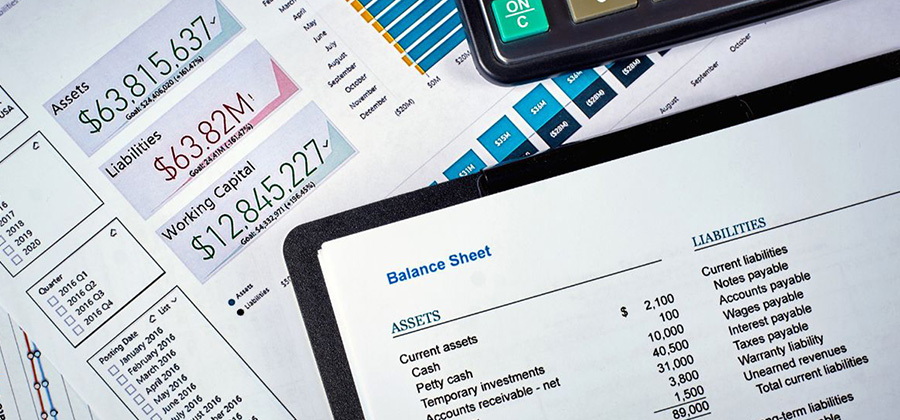Businesses expect accounting professionals to prepare balance sheets on a quarterly basis. Some types of businesses need them completed monthly. A balance sheet is a financial document that provides insight into the financial health of the business. Balance sheets give details such as assets, liabilities, and shareholder equity.
A balance sheet is important to a business in many ways. The balance sheet is organized in such a way that it provides a snapshot of finances all in one place. It’s also critical to financial planning. The balance sheet is presented to owners or managers along with two other important documents, the cash flow statement and an income statement.
Accounting balance sheets are an accurate way to analyze a business’s financial position. When completed, a balance sheet contains crucial information, including what the business owns, how much the business owes, and how much has been invested into the business to date. When financial information is “balanced” on the balance sheet, the company’s assets will equal the liabilities and equity combined.
Preparing a balance sheet is a standard process for accounting professionals. The steps are established and well-organized. But if you are just starting out, it can be a bit overwhelming. To help you get started, here are the basic steps for preparing a simple balance sheet.
1. Determine the reporting period and date.
One purpose of a balance sheet is to show the business, its assets, liabilities, and shareholders’ equity on a specific day of the year or at a specific point in time. Most companies and corporations prepare financial reports at the end of each quarter. In some instances, companies choose to prepare monthly balance sheets, which are typically reported on the last day of the month. When learning how to make a balance sheet, even though it contains the same steps, businesses can prepare them specifically based on their business needs.
Below are ways to determine the reporting period and date.
- Annual reporting periods follow the calendar year. They start on January 1 and end on December 31. This is the same for every year.
- Reporting periods may start or end on different dates that coincide with the fiscal year.
- A fiscal year reporting period may start on June 1 and end on May 31.
Reporting dates and well-defined periods help provide a good picture of the company’s financial health. Shareholders and owners use this information to evaluate how well the business is reaching its financial goals. They also help them determine new goals.
2. Identify Your Resources
After identifying the date, the next step for how to create a balance sheet is to make a list of all the current assets. Resources are defined as anything that provides funding or financial benefit for the business. These may be financial, human, material, or intellectual resources that are counted as assets. Each asset should be listed on a separate line on the balance sheet. To keep assets organized and help the balance sheet make sense, they are usually separated in order of their liquidity. Items with more liquidity, such as accounts receivable and cash, should be listed first. Then less liquid assets such as inventory are listed last. After listing current assets, include long-term or non-current ones. Also, remember to include non-monetary assets.
Once your assets are listed and categorized, total them all up. Your final tally will be listed under the “total assets” category. The way to ensure this figure is correct is to double-check it against the general ledger.
Below are ways to identify your resources.
- Identify assets/resources as anything having an economic benefit.
- Place resources in the proper accounting category.
- Add up all the resources.
A resource in accounting is anything that adds economic value to the business. These can be difficult to determine in some instances, but they help balance everything out in the long run. All resources should be identified and listed.
3. Establish Your Liabilities
Liabilities are what the company owes. They may be short-term or long-term. Knowing the total amount of liabilities against the company helps prepare and plan for future growth. Investors are also interested in liabilities as it gives them a good idea of the company’s financial health. Below are ways to establish your liabilities.
- List short-term liabilities.
- List long-term liabilities.
- Add all short-term liabilities together.
- Add all long-term liabilities together.
- Add the two subtotals together to find the total liabilities.
Liabilities chip away at the financial resources of a business. It’s essential for shareholders and owners to understand the company’s liabilities. They are used to offset the assets. And they help provide a more well-rounded image of its financial health and outlook.
- Calculate the Equity of Shareholders
Calculating shareholders’ equity can seem overwhelming when you are learning how to prepare a balance sheet. But it’s actually straightforward, especially if the business has a single private owner. For a publicly held company, calculating shareholders’ equity can be a bit complicated depending on the different types of stocks. This section of the balance sheet will include common stock, preferred stock, treasury stock, and retained earnings. The owner’s and shareholder’s equity is calculated using working capital and retained earnings.
Below are the steps for calculating shareholder equity.
- Total all the company’s assets.
- Total all the company’s liabilities.
- Subtract the total liabilities from the total assets to find the shareholder’s equity.
Shareholders need to know they are getting a return on their investment. Calculating their equity helps give them peace of mind and lets them know the company is headed in the right direction.
5. Compare Assets to Total Liabilities
A balance sheet must be balanced. One way to make sure it is balanced is by comparing assets to total liabilities. It’s a relatively simple process that all accounting firms and professionals must know how to do.
Below are ways to compare assets to total liabilities.
- Add the equity to the total liabilities.
- Compare the company’s assets against that total.
- It’s done correctly if the company’s equity plus liabilities equals its assets.
- Double-check if the two are not equal.
The company’s assets and liabilities should balance each other out. This is a test to see if the books balance. When this step is done correctly, assets should be equal to the company’s equity (profits) plus its liabilities.
When do you Prepare the Balance Sheet?
The balance sheet provides a statement of a business’s assets, liabilities, and owner/shareholder’s equity on a specific date. Accountants may prepare a balance sheet at any time, for any period. The timing may be adjusted to the company’s needs. In most instances, balance sheets are prepared at the end of a standard set period, such as each quarter or annually. However, many businesses, especially larger corporations, may ask accountants to prepare monthly balance sheets.
Who is in Charge of Preparing the Balance Sheet?
Accountants work with the financial information of a business. They create financial statements including balance sheets. An accounting professional ensures balance sheets and other financial documents are up-to-date and in compliance with local and federal regulations. The balance sheet is created by someone in the accounting department. Larger businesses usually have large accounting departments that hire numerous people. An accountant may prepare balance sheets, or they may oversee another individual who is specifically trained to create them.
What is the Balance Sheet Format?
The balance sheet contains the assets, liabilities, and equity of a company or organization on a specific date. The balance sheet is organized into three sections; one section for the assets, one for the liabilities, and the final section for the equity. The first section contains a list of all the resources or assets. The assets are grouped by similar characteristics. The standard format for a balance sheet is to divide the assets into two categories: current and non-current.
The second section lists the company’s liabilities or obligations to other businesses or third parties. The current liabilities are grouped together, and the long-term liabilities are grouped. The final section in the format includes the owner’s equity if the business is a partnership or a sole proprietorship. If the business structure includes stockholders, then the term “owner’s equity” is replaced with ‘stockholders equity.”
Are Balance Sheets Always Equal?
Yes. If the assets are not equal to the equity plus the liabilities, then there is a mistake in the calculations. This financial document is called a “balance” sheet because it demonstrates that all the assets are equal to the company’s liabilities coupled with the shareholders’ equity. The two totals should be the same due to the use of double-entry accounting.
What Happens if your Balance Sheet does not Balance?
If a balance sheet doesn’t balance, then the preparer must find the mistake. The balance sheet may contain a mistake that may be easy to fix. If there isn’t a mistake on the balance sheet itself, then the information on the balance sheet must be compared to the general ledger to see if a mistake was made when the information was entered.
What are the Advantages of Having Balance Sheets?
Balance sheets provide many benefits for large and small businesses. The information on the balance sheet is used to calculate helpful ratios that help determine the short-term financial outlook and the long-term profitability of a company. Since the balance sheet provides an organized view of current liabilities and long-term debt, it can be useful for planning future financial decisions, such as purchases or hiring. It also helps companies plan for future growth.
Investors may use your balance sheet to determine their risk factors. The balance sheet provides investors, lenders, and shareholders with a view of your company’s assets, liabilities, and net worth. Comparing past balance sheets offers a glance at the financial trends of a company, ensuring investors they will get their money back.
Is the Balance sheet the Most Important Financial Statement?
No. A balance sheet is one of three important financial statements companies need and value. Choosing the “most” important financial statement may vary between businesses based on their specific needs. However, if given a choice, the most important financial statement is likely to be the income statement because it reveals the business’ ability to generate a profit.
Is it True that a Balance Sheet Helps with Financial Planning?
Yes, it is true that balance sheets are helpful when it comes to financial planning. It is a statement of the financial health of a company at a certain time. The balance sheet describes the resources of a company and how they were acquired. Viewing the company’s resources and worth is a great place to start with financial planning. Assessing the information on balance sheets is critical for businesses that want to grow.
Are Financial Ratios Calculated Using the Balance Sheet?
Yes, five financial ratios are often calculated using the information contained on a balance sheet. The working capital ratio, current ratio, and acid test (or quick) ratio are liquidity ratios that help a company determine if it can pay its obligations as they come due. Two other financial ratios calculated from balance sheet amounts include the debt to equity ratio and the debt to total assets ratio. These two ratios give information on the financial leverage or use of debt for a company.



